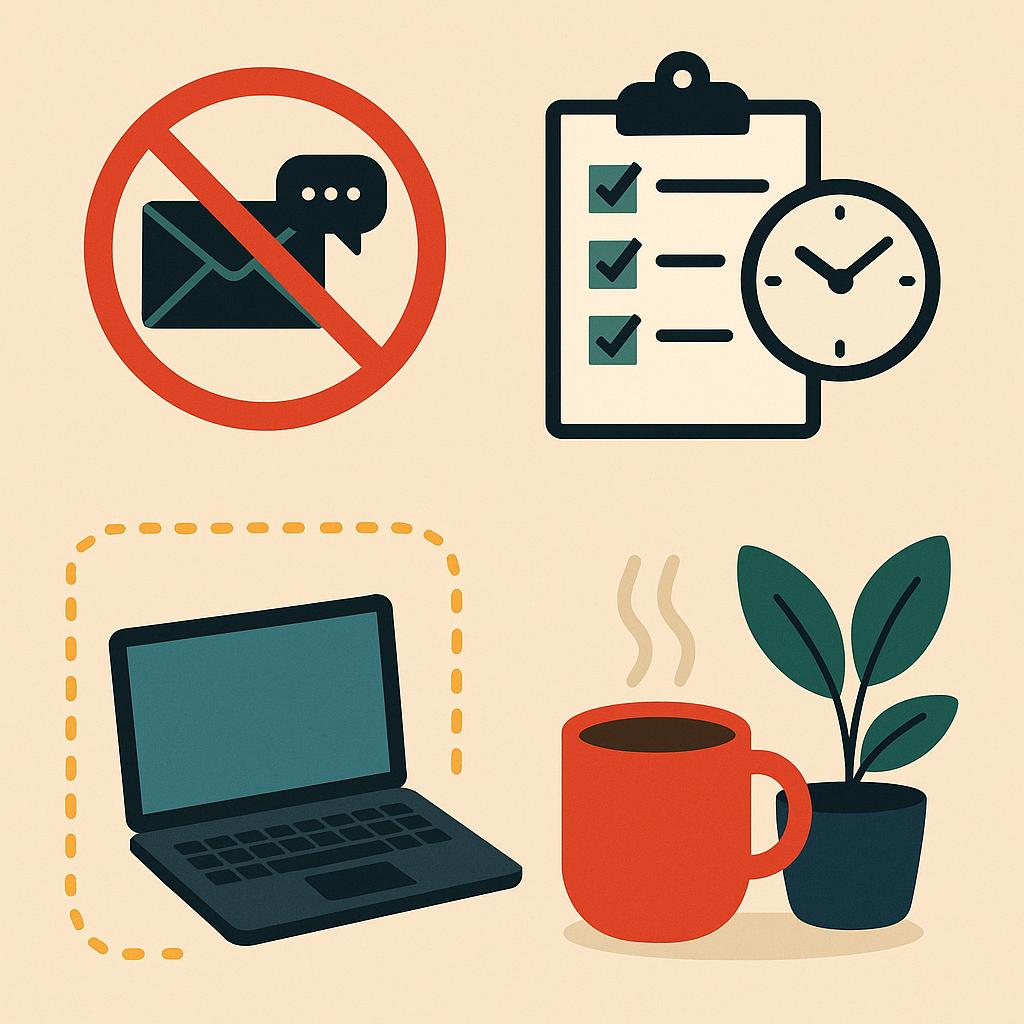Hybrid Work: How to Plan Your Day to Be Truly Productive
Hybrid work – a mix of office and remote days – has become the new normal in many companies. And while it gives us flexibility (morning traffic replaced by coffee in your kitchen), it also demands structure. To make your day count, you need routines, focus techniques, and digital tools that keep you on track.
Here’s how to organize your hybrid workday for maximum productivity – especially if you’re glued to your screen most of the time.
Start With a Ritual, Not Email
Don’t start your day by randomly scrolling through Slack or your inbox. Instead, begin with a short morning ritual. The evening before, write down 2–3 top priorities. That way, when you “enter the office” (even your home one), you already know what to tackle first.
If possible, push operational meetings to the afternoon and save the morning for deep work. Add your lunch break and coffee pauses to the calendar, too. Protecting your breaks helps you recharge rather than burn out by 2 p.m.
Your workspace matters. If you can, bring gear from the office: a second monitor, ergonomic mouse, or a keyboard you actually like. Headphones are non-negotiable – they’re your gateway to focus whether you’re home or in a café.
Time Management Tactics That Actually Work
Try the Pomodoro Technique – work in 25-minute focused sprints followed by short breaks. After four rounds, take a longer break. This method helps avoid burnout and makes boring tasks less dreadful.
Another great trick is Time Blocking – assign fixed time slots in your calendar for specific tasks. Need to write a report? Block 10:00–12:00. Have a weekly sync at 14:00? Don’t schedule anything heavy before it. This structure reduces context-switching and helps you stay in control.
Prefer visual thinking? Try the 1-3-5 rule (1 big, 3 medium, 5 small tasks a day) or the Eisenhower Matrix to sort priorities.

Tools That Save the Day
Want a digital brain? Use Notion – it’s perfect for daily to-do lists, project tracking, even team dashboards. Prefer visual boards? Go for Trello or Asana. These tools are ideal for teams but also work great solo.
Need a timer? Try Focus To-Do, which combines Pomodoro timers with task lists. Or go deeper with Toggl or Clockify if you want to measure how much time you really spend answering emails vs. doing the actual work.
And don’t underestimate Slack or Teams. Use /remind to schedule gentle nudges, /dnd to mute distractions, and organize your channels smartly. These aren’t just chat apps – they’re your command center.
Beat the Distractions
Let’s face it – distractions are everywhere. The key? Control your environment. Close unnecessary browser tabs. Install StayFocusd to block time-wasting websites (hello, social media). Or go big with Cold Turkey or Freedom – apps that lock you out of tempting sites completely.
Enable “Do Not Disturb” on your phone and desktop – notifications can wait. Set clear “offline hours” where you’re not on Slack or email. Trust us, most things can wait 30 minutes.
And here’s a tip: use /collapse on Slack to hide GIFs and images. It sounds silly, but eliminating visual clutter boosts focus in surprisingly big ways.
Organize Your Workspace Like a Pro
Hybrid work needs a hybrid-friendly space. Invest in an ergonomic chair and desk – your back will thank you. Make sure your screen is eye-level and lighting isn’t too harsh. Keep your desk clean, with only essentials within reach.
Carve out a dedicated work corner. If you don’t have a separate room, use a consistent spot that becomes your “office.” This mental separation between work and personal life makes a difference. Even a favorite mug for your morning coffee can become part of your work ritual.
Let your household know when you’re working, especially if you’re home. Clear boundaries (like working hours from 8:00 to 16:00) reduce random interruptions and keep you in the zone.
Final Thoughts
Planning your day in a hybrid work setup is about mixing flexibility with structure. Morning rituals, time management techniques like Pomodoro and Time Blocking, and the right tools (Notion, Trello, Focus To-Do) will make your workday smoother. Don’t forget to fight off distractions and protect your deep focus time.
And most importantly – set up your space to support you, not drain you. When your desk feels like a command center and your calendar actually reflects your real priorities, even Monday mornings feel doable.